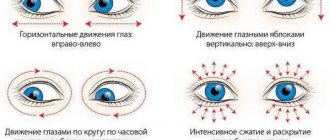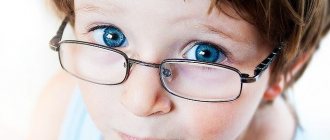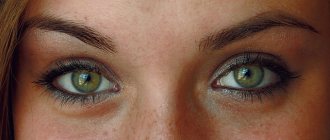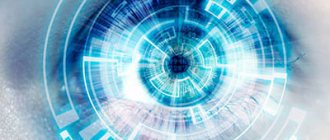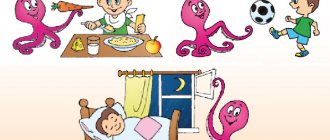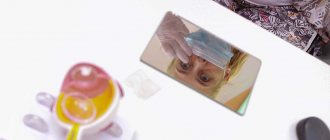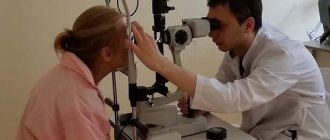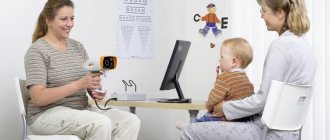The figurative and, in fact, accurate expression “lazy eye” is a literal translation of the Greek term “amblyopia”. This is what ophthalmology calls a condition when one eye sees much worse than the other and becomes a hindrance, instead of remaining a weak, but still “working” channel for the receipt of visual information. In such cases, the brain cannot merge two separate images into one stereoscopic, binocular one. The central nervous system, trying to maintain at least monocular vision, begins to ignore the distorted signal and gradually excludes the affected eye from the processes of analysis and construction of a visual image. Deprived of its natural loads, an unused eye quickly degrades as an organ of vision - just as muscles that are not used by a lazy person weaken and atrophy; hence the name of the disease proposed by Aristotle.
Lack of binocular vision is the most important clinical characteristic of amblyopia. Accordingly, the main goal of treatment is to restore volumetric perception, the ability to estimate distances, the relative position of objects and, in general, the depth of the surrounding space. In most cases, amblyopia can be corrected or cured completely - in children and adolescents, and sometimes even in old age - and only in the most advanced forms leads to irreversible and complete loss of visual functions.
Purpose and types of gymnastics
Previously, amblyopia in children was treated by literally forcing the healthy eye to work. The child was put on special glasses, where the clearly visible eye was covered. At the age of up to 6 years, this technique is quite effective. In older children, it is more difficult to correct vision.
Special exercises and devices that stimulate the affected eye can increase the effectiveness of therapy. A complex of therapeutic exercises develops color perception and improves spatial vision.
In an outpatient or hospital setting, passive and active techniques are used. In the first case, the exercises are performed with special devices and take at least an hour. The result is training of the sore eye and alignment of vision. In the second case, they resort to various activities that improve spatial orientation and develop fine motor skills. Exercises will certainly involve the affected eye.
Exercises to treat amblyopia at home include various games, charades, modeling, etc. The same therapeutic techniques are provided for children as for adults. However, their recovery occurs much faster, so treatment should be started as early as possible.
Exercise techniques
To successfully treat amblyopia, it is necessary to first eliminate the root cause: astigmatism, stress, myopia, strabismus, etc. Eye gymnastics acts as an auxiliary method of therapy and gives positive dynamics only in combination with other treatment options.
There are several techniques that are used to correct amblyopia.
Goncharova-Küppers technique
The Goncharova-Küppers principle is based on the use of a 60-watt electric lamp. A circle with a diameter of 7–10 mm is cut out of opaque paper and pasted onto the lamp. A bandage is applied to the healthy eye. The patient is seated in a dark room at a distance of 50 cm from the switched on lamp, and he looks at the circle.
One session consists of three approaches of half a minute. After each 30-second session, the patient turns his gaze to a light sheet and looks at it until the dark circle that appears before his eyes disappears.
The method is used for a period of one to three months daily.
Exercises with a light bulb
A similar exercise is performed with a 100-watt light bulb. A cap made of dark paper or fabric is put on it. A hole with a diameter of 3–5 mm is made in the center and covered with red glass or film. The patient is seated in front of the switched on lamp at a distance of half a meter. A bandage is put on the healthy eye. You need to continuously look at the colored circle for two minutes. In this case, the lamp is turned off for several seconds at regular intervals.
The optimal period of use is three months.
Eye gymnastics for strabismus
Since with amblyopia the patient often develops strabismus, simultaneously with the above-mentioned exercises it is recommended to perform gymnastics to eliminate this defect:
- One hand is raised up and the index finger is slowly brought closer to the nose. Carefully watch the finger, smoothly moving it from top to bottom;
- perform circular rotations with the pupils, reminiscent of the number “8”;
- play with a small ball, following its movements with their eyes and trying to focus on it. This exercise trains the eye muscles;
- When working at the computer for a long time or reading a book, they periodically turn their eyes to the window and look at foreign objects.
Zhdanov method
Zhdanov’s gymnastics has proven itself well among patients with various eye pathologies. When used systematically and correctly, this set of exercises provides favorable results. Before performing gymnastics to treat amblyopia, perform the following steps:
- remove lenses and glasses from the eyes, if any;
- relax. Eye exercises for amblyopia are performed in a leisurely manner and assume a calm mood;
- Find a comfortable, quiet room where you can concentrate.
After serious injuries and operations, gymnastics is contraindicated.
Gymnastics consists of seven exercises. All of them are simple and do not require special training:
- Blinking. You need to blink quickly, tensing your muscles as little as possible.
- Horizontal lines. I draw a horizontal line with my eyes five times in each direction.
- Diagonal lines. Diagonal lines are drawn with the eyes five times in each direction.
- Vertical lines. Make lines with your eyes from bottom to top and vice versa. Five approaches each.
- Rectangle. Draw a geometric figure with your eyes several times.
- Zigzag. Draw a curved line in different directions.
- Circle. Smoothly move the pupils, first clockwise, then in the opposite direction.
After each exercise, blink your eyes for 5–10 seconds.
Gymnastics is indicated for any eye pathologies of varying severity, including amblyopia in adults and children.
Tips for at-home lazy eye workouts
It is advisable to complement occlusion therapy with the following exercises for amblyopia, which are technically called “pleoptic training”. They are carried out in specialized orthoptic clinics using the necessary devices.
It is also important to do additional exercises at home. It is not enough to simply cover the healthy eye; it is important to try to make the amblyopic eye work.
Exercises for children and adults are practically no different. The main difference is that adults must devote more time to exercise. Suitable activities for training a healthy eye:
- assembling mosaics, puzzles;
- modeling from plasticine or clay, wood carving;
- coloring books - you should start with larger and simpler pictures, gradually moving towards smaller and more complex images;
- outlining - through transparent paper with a colored pencil along a pre-drawn line with a brush or watercolor;
- pinning image templates;
- exercises on the line - on a pre-drawn line, a person traces circles, squares or other more complex shapes, trying to trace exactly along the line, in addition, you can stick to pre-cut shapes from colored paper;
- stringing beads;
- cutting and folding models - various patterns and details are cut out (from thick paper, fabric, felt, etc.) and attached or glued to each other, you can make houses, flowers, cars, etc., you can also cut a picture into several parts, and then assemble it into the original image;
- fixation on dots - draw several dots on paper, which you will later connect into drawings, such as flowers in a vase;
- embroidery - you can embroider on paper or fabric with colored threads, this exercise is very effective because it forces you to concentrate;
- games - checkers, cards, chess, dominoes, etc.;
- movement - ball games, table tennis, line walking;
- reading - you should start with text in large font, moving to smaller ones;
- computer games, watching TV (for a limited time).
The more the acuity of the amblyopic eye increases, the more subtle the activities and games that are included in the training should be. The more visually intense activities a person engages in, the faster their amblyopia will improve.
Games, puzzles, tasks
Performed to develop fine motor skills. During the game, the patient simultaneously works with his hands and eyes, which contributes to the development of visual function. Drawing small objects with many edges is encouraged.
Examples of games:
- Draw a simple geometric figure on a sheet of paper. The patient's healthy eye is closed and, looking only at the defective one, he must redraw it;
- A table lamp is placed at a distance of 5–6 meters from the patient, and a picture is hung not far from it. They look first at the lamp for a few seconds, then look at the picture;
- prepare two drawings with objects or letters. Images must be of different sizes. Place in front of the patient so that when focusing on one, lateral vision affects the second. Alternately look from one drawing to another;
- the patient faces the light source. A sheet with text printed on it is smoothly brought to it. As soon as the patient ceases to distinguish what is written, the sheet is also smoothly taken back.
What it is
This is a functional decrease in vision due to the non-participation of one eye in the visual process. Each eye observes its own picture, different from the picture of the other eye. The brain is not able to combine these images into one. As a result, the work of one of the eyes is suppressed.
People suffering from amblyopia lack binocular vision, that is, the brain correctly compares images from two eyes into one. This ability of the brain allows you to evaluate:
- the order of arrangement of objects in the visual field,
- image depth,
- integrity of the perceived picture,
- volume of perception.
All of the above features are not available if you have this condition.
Detailed instructions on what to do if your eyes hurt from the computer? Description of the correct prevention and treatment of the disease.
The article (here) is about the character of people with green eyes.
Computer programs
To avoid surgery for amblyopia, treatment at home using computer programs is allowed. They allow you to easily and naturally correct your vision.
Program therapy is aimed at:
- improving the processes of constructing a visual image;
- coordinated work of two eyes;
- development of eye muscles.
Program "Flower"
An interactive children's game with three levels. Each of them has different image sizes. A flower with pictures on the core and petals is visible on the screen. It is necessary to find the same pattern that is depicted on the core.
The program is effective for the treatment of amblyopia at the initial stage of development. During the game, the search for a pair is carried out only with the defective eye.
Classes are conducted under adult supervision. Before you begin, you should test your healthy eye so you know what results to expect. The game is played in a calm palette that does not cause fatigue. There are no complicated controls, so it is suitable for younger children.
Program "Crosses"
You need to catch a cross. The screen shows a board resembling a chess board. The number of cells and their size depend on the difficulty and level. The player moves the mouse cursor over a cell and it changes color. A cross appears in different parts of the board, and the player’s task is to catch it.
The workout will appeal to adults and children. The process involves neurons that improve eye motor activity and contrast perception. By changing colors, color perception improves. And changing the size of cells improves the functioning of receptive fields.
Spider program
On the screen, the player sees two webs - one in the center, the other appears in different places. One with a radial grille, the second with a spiral grille. To win, you need to bring together the centers of the webs.
The game "Spider" has a beneficial effect on clarity of vision at different distances, improves eye movements that follow an object and spatial orientation.
Program "Contour"
The game takes a creative approach to treating amblyopia. The player puts on special glasses. With one eye he sees the image, and with the help of the other he must complete it. In total, the game has about 40 drawings of varying degrees of complexity.
Program "eYe (Ay)"
It consists of several exercises aimed at normalizing stereoscopic vision. Difficulty parameters are set by the players. The game is based on methods aimed directly at treating amblyopia. Red-blue glasses are used to separate the visual fields.
The complex includes the games “Shooting Range” and “Pursuit” to improve the quality of vision, correct fixation and localization. There are also merging and matching games that develop the combined work of both eyes. Among the tasks there is a “Trainer” exercise to determine the quality of depth vision, various game tests and constructor tests.
The mandatory course consists of 10–15 procedures lasting about 30 minutes.
↑ Introduction
Concomitant strabismus
occurs in 2-3% of children. In addition to a very psychologically painful cosmetic defect, this disease is accompanied by a serious disorder of binocular and monocular visual functions. At the same time, the effectiveness of modern methods of treating amblyopia and strabismus reaches 50-60%. In this regard, the problem of improving existing and finding new methods of treating patients with this pathology is of great medical and social importance.
New opportunities in solving this problem are associated with the widespread use of personal computers with fairly high-quality monitors in the practice of medical institutions.
The recommended method for the treatment of amblyopia is based on the patient independently performing exercises under the guidance of a physician, combining irritation of the retina with light with the development of localization abilities, and for the treatment of strabismus - exercises for combining and merging images of paired test objects, developing the friendly activity of both halves of the visual analyzer. The method for correcting binocular vision is protected by a Russian patent.
The method is implemented using a specially developed software package for an IBM PC AT computer, which provides:
- Synthesis of both color and monochrome images of test objects, the size, shape, location and speed of movement of which can vary widely depending on the treatment task assigned to the patient, his age and other factors.
- Quick change of presented images in a given sequence, taking into account the diagnosis and characteristics of a particular patient.
- Conducting treatment in a playful manner with the active participation of the patient, which increases his interest and thereby reduces treatment time.
- Highly accurate measurement and recording of the results of each exercise at any stage of treatment.
Rules for performing exercises
When correcting vision, it is important to exercise regularly. They are carried out every day at approximately the same time. There will be no benefit from long breaks. It is advisable to devote at least an hour a day to health so that the situation changes for the better.
Rules for performing gymnastics:
- the healthy eye is covered with a bandage;
- to prevent overexertion, every two to three seconds the eyes are directed into the distance;
- a set of exercises is done twice a day.
If the ophthalmologist has diagnosed amblyopia, he will recommend suitable treatment methods to the patient. Gymnastics is effective in the first stages of the disease. For high-grade amblyopia, treatment in children and adults is carried out under the strict supervision of a physician using hardware techniques. In case of urgent need, surgical intervention cannot be ruled out.
Causes of amblyopia
The reasons for the violation may be:
- Strabismus.
Amblyopia of the eye in children can be both the cause of strabismus and its consequence. In the first case, it manifests itself when binocular vision is impaired due to uncoordinated eye movements. In the second, due to the imperfection of the image transmitted to the visual area of the brain. As a rule, it is the squinting eye that becomes “lazy”.
Cataracts, clouding of the cornea or lens, eyelid ptosis.
Physiological pathologies of the visual organs interfere with the formation of a clear image on the retina. The distorted image cannot be adequately processed by the brain: as a result, the work of the affected eye is suppressed.
Anisometropia.
Amblyopia is caused by disturbances in refraction - the refractive power of the optical system, expressed in diopters. Deterioration of vision due to astigmatism, myopia or farsightedness can also cause lazy eye syndrome.
Heredity.
A history of amblyopia in adult relatives can affect the onset of the disease in a child.
Injuries.
Exposure to toxins.
Risk factors for amblyopia in a child include conditions such as prematurity, cerebral palsy, low birth weight of the newborn, retinopathy, and mental retardation.
Visual impairment
